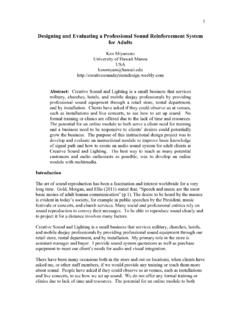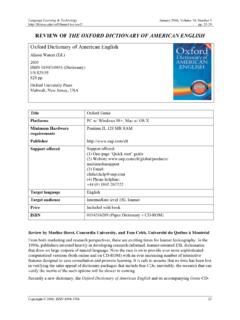Transcription of Big Data: Issues and Challenges - University of Hawaiʻi
1 Proceedings of the 52nd. Hawaii International Conference on the System Sciences, HICSS 52, Maui, Hawaii, 2019. big data Redux: New Issues and Challenges Moving Forward J. Alberto Espinosa American University Stephen Kaisler SHK & Associates Frank Armour American University William H. Money The Citadel Abstract As of the time of this writing, our HICSS-46 proceedings article has enjoyed over 520 Google Scholar citations. We have published several HICSS proceedings, articles and a book on this subject, but none of them have generated this level of interest. In an effort to update our findings six years later, and to understand what is driving this interest, we have downloaded the first 500 citations to our article and the corresponding citing article, when available.
2 We conducted an in-depth literature review of the articles published in top journals and leading conference proceedings, along with articles with a high volume of citations. This paper provides a brief summary of the key concepts in our original paper and reports on the key aspects of interest we found in our review, and also updates our original paper with new directions for future practice and research in big data and analytics. 1. Introduction As of the time of this writing, our HICSS article titled big data : New Issues and Challenges Moving Forward [1] has enjoyed over 560 Google Scholar citations (see: ).
3 We argued that big data is the new business and social science frontier and that the amount of information and knowledge that can be extracted from the digital universe continued to expand rapidly. We also concluded that big data is just the beginning of the problem. Technology evolution and placement guarantee that in a few years more data will be available in a year than has been collected since the dawn of man. This is proven to be true, and the new challenge we face is that big data is becoming really big data as larger volumes of more complex and dynamic keep accumulating in gigantic databases.
4 Our original paper discussed important Issues and Challenges that would require concerted research efforts. We concluded these major Challenges had to be addressed within the next decade. Six years later, we concurred that it was important to evaluate where the big data field has evolved and where it is going. The high citation level of our original HICSS-46 article offers us the opportunity to do that. In order to understand the specific Issues that have generated the most interest in our original article, we conducted a targeted literature review on its first 500 citations. We skimmed all articles goals for the present study are to: (1) better understand the big data Issues that matter the most to practitioners and scholars; (2) identify new Issues that authors have uncovered; and (3) update our findings to provide new insights into the future direction of research in big data and analytics.
5 In this paper we provide a summary of the key concepts and Issues reported in our original paper, followed by a summary of our review findings for each. We then discuss the new Issues reported in the citing articles, and present our conclusions. 2. Method For this study, we selected: all articles published in premier journals and leading conference proceedings; all articles with 50 or more Google Scholar citations; and all HICSS articles. This selection process yielded 107 articles. We read and analyzed these paper, but noted that 53 of them did not contribute anything new, but just repeated content from other articles.
6 Thus, we used all 107 articles for topic counts, but only the 54 remaining articles for in depth analysis. 3. Issues and Challenges Revised Definitions of big data . Our prior HICSS article reported that the early conceptualization of big data was large volumes of data just beyond technology s capability to store, manage and process efficiently by traditional database methods and tools. We concluded that this definition was not useful, making the definition of big data a moving target because data technologies improve dramatically every year. We favored a definition based on the 3V s below. Review: Many authors have provided big data definitions, but the majority agree with our perspective that a definition based on the 3V s provide a better grasp of what big data is about.
7 The 3V s of big data We reported that most big data researchers had adopted Doug Laney s classic perspective from 2001 [2], that the main big data Challenges resided along key dimensions, commonly referred as the 3V s of big data Proceedings of the 52nd Hawaii International Conference on System Sciences | 2019 URI: : 978-0-9981331-2-6(CC BY-NC-ND )Page 1065 Proceedings of the 52nd. Hawaii International Conference on the System Sciences, HICSS 52, Maui, Hawaii, 2019. Volume, Velocity and Variety. The intuitive appeal of these 3V s led to some consensus for a definition of big data as high volume, high velocity, and/or high variety information assets [3].
8 Review: The 3 V s continue to be dominant. The simplicity and appealing concept of the original 3 V s has generated a gold rush (by us and others) to discover and propose new V s ( , value, variability, veracity, validity, etc.). However, the original 3V s seem to be the most stable and fundamental dimensions of big data that really matter to most. Of the new V s proposed, veracity is gaining more acceptance because of the big data cleansing Challenges . We argue that validity is captured in veracity, variability is already captured in velocity and variety, and value is dependent on the user, not on the informational content. One author proposed that it is better to think of big data along a continuum, from small data , to bigger data , to big data depending on the magnitude of each of the 3 V s [4].
9 Main Challenges of big data Table 1 and Figure 1 show, the Issues and Challenges that have received most attention include: growth rate; tools and talent; management and analytic Challenges . The Issues and Challenges that received very little or no attention include: time to information; data ownership; needle in the haystack; turning straw into gold and predicting the world. Also, a large proportion of the articles raised new Issues and Challenges discussed below. Each challenge includes the number of papers that discussed (in parenthesis) the issue in depth, followed by a summary from our HICSS 2013 paper and a review of the new literature on each issue.
10 Figure 1: Issue Popularity Topic (rank ordered) Count Analytics Challenges 33 ( ) data Storage and Transport 27 ( ) Management 25 ( ) Tools and Talent 24 ( ) Growth Rate 23 ( ) data Validation 17 ( ) Privacy 15 ( ) data Input and Output Process 14 ( ) Compliance and Security 12 ( ) Structured and Unstructured data 10 ( ) data Growth and Expansion 8 ( ) Hybrid data 7 ( ) data Ownership 5 ( ) Time to Information 2 ( ) Turning Straw into Gold 2 ( ) Needle in the Haystack 1 ( ) Predicting the World 0 (0%) Table 1: Number of Papers Discussing Old Topics Growth Rate (GR, 23). The staggering rates of increase in the amount and complexity of data collected up to 2013 pale in comparison to today s growth rate.



















